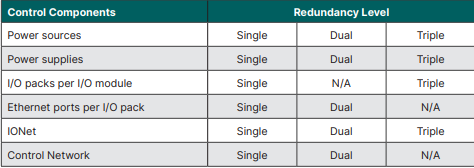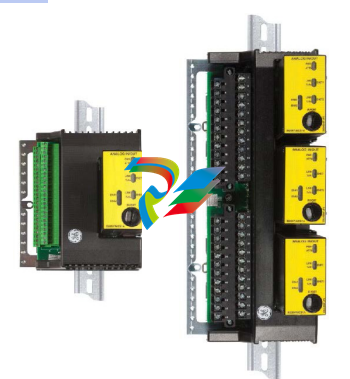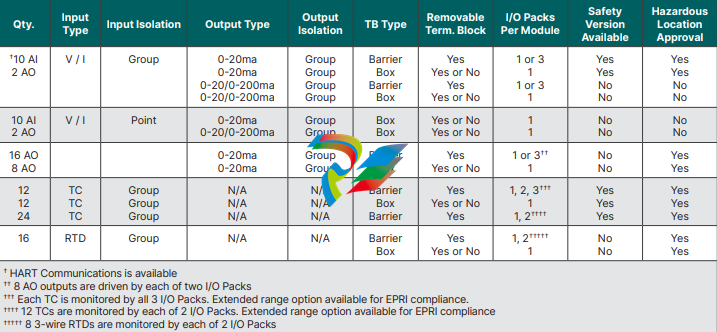
GEMARK* VIE CONTROL PRODUCT DESCRIPTION
INTRODUCTION
The Mark* VIe control system is a flexible platform used in multiple applications. It features
high-speed, networked input/output (I/O) for simplex, dual, and triple redundant systems.
Industry-standard Ethernet communications are used for I/O, controllers, and supervisory
interface to operator and maintenance stations, as well as third-party systems. The
ControlST* software suite, which contains the ToolboxST* toolset, is used with Mark VIe
controls and related systems for programming, configuration, trending, and analyzing
diagnostics. It provides quality, time-coherent data in the controllers and at the plant level for
effectively managing control system equipment. The Mark VIeS Safety control is a stand-alone
safety control system for safety-critical applications that conform to IEC®-61508. It also uses
the ControlST software suite to simplify maintenance, but retains a unique set of certified
hardware and software blocks. The ToolboxST application provides a means to lock or unlock
the Mark VIeS for configuration and safety instrumented function (SIF) programming.

SYSTEM OVERVIEW
A single-board controller is the heart of the system. The controller includes
the main processor and redundant Ethernet drivers to communicate with
networked I/O, and additional Ethernet drivers for the control network. A
real-time, multi-tasking operating system is used for the main processor
and I/O modules. Control software is provided in a configurable control
block language and stored in non-volatile memory. It is similar to IEEE® 854
32-bit floating-point format, and Sequential Function Charts (SFC) are also
available for complex sequencing.
The I/O network (IONet) is a dedicated, full-duplex, point-to-point
protocol. It provides a deterministic, high-speed 100 MB communications
network that is suitable for local or distributed I/O devices, and provides
communication between the main controllers(s) and networked I/O
modules. Online controllers continuously read input data directly
from the IONet, which is available in single, dual, and triple redundant
configurations. Both copper and fiber interfaces are supported.
The Mark VIe I/O modules consist of three basic parts: the terminal board,
the terminal block, and an I/O pack. Barrier or box-type terminal blocks are
mounted on a terminal board, which mounts on a DIN rail or base in the
control cabinet. The I/O pack contains two Ethernet ports, a power supply,
a local processor, and a data acquisition board. I/O capability grows as I/O
packs are added to the control system, enabling use in a simplex, dual, or
triple redundant configuration. Some process sub-systems require even
more throughput; therefore, the local processors in each I/O pack run
algorithms at higher rates as required for the application.
REDUNDANCY
Every application has different requirements for redundancy depending on
the criticality of the process. The Mark VIe control system provides a wide
range of redundancy options for local and remote distribution.

Dual redundant systems transmit inputs from single or redundant input
packs on dual IONets to dual Mark VIe controllers. Controllers then run
application software and transmit outputs to output packs. Three output
I/O packs may be provided to vote output signals for mission-critical field
devices. Dual redundant systems may be configured for single, dual, and
triple redundant sensors.
Triple redundant systems protect against soft or partial device failures. A
failed component is outvoted with a 2-out-of-3 logical selection (vote) or
a median value selection. Control software in all three Mark VIe controllers
runs on the voted value of the signal while diagnostics identify the failed
device. These sophisticated diagnostics reduce the mean-time-to-repair
(MTTR) while the online repair capability increases the mean-timebetween-forced-outages (MTBFO). Field sensors for these systems may
be single, dual, or triple.
I/O INTERFACE
One or multiple I/O packs are mounted on each module to digitize the
sensor signal, run algorithms, and communicate with a separate controller
containing the main processor. I/O packs have a local processor board
that runs a real-time operating system and a data acquisition board that
is unique to the specific I/O application. Local processors run algorithms
at faster speeds than the overall control system, such as the regulation of
servo valves performed within a servo module.
Each I/O processor has a local temperature sensor accurate to ±2°C (±3.6
°F). Detection of an excessive temperature generates a diagnostic alarm
and the logic is available in the database (signal space) to facilitate control
action or unique process alarm messages. The temperature is continuously
available in the database. I/O module features include:
• Dual 100 MB Ethernet ports
• 100 MB full-duplex ports
• Online repair per I/O pack
• Automatic reconfiguration
• Accuracy is specified over full operating temperature
• Internal temperature sensor
• LEDs:
- Power status and attention
- Ethernet link-connected and
communication-active
- Application-specific
• 28 V dc power
• Internal solid-state circuit breaker and soft start
A power supply provides a regulated 28 V dc power feed to each I/O pack.
The negative side of the 28 V dc is grounded through the I/O pack metal
enclosure and its mounting base. The positive side has solid-state circuit
protection built into the I/O pack with a nominal 2 A trip point. Online repair
is possible by removing the 28 V dc connector, replacing the I/O pack, and
re-inserting the power connector. I/O packs are automatically reconfigured
if the Auto-Reconfiguration feature is enabled.
TERMINAL BLOCKS
Signal flow begins with a sensor connected to a terminal block on an I/O
module. The terminal board mounts to the cabinet and is available in two
basic types: T-type and S-type modules.
T-type modules typically fan the inputs to three separate I/O packs.
They contain two removable 24-point, barrier-type terminal blocks. Each
point can accept two 3.0 mm2 (#12,AWG) wires with 300 V insulation per
point and spade or ring-type lugs. Captive clamps are also provided for
terminating bare wires. Screw spacing is 9.53 mm (0.375 in) minimum,
center-to-center. T-type modules are normally surface mounted, but may
also be DIN-rail mounted.
A shield strip is provided next to each block, which is actually the left-hand
side of the metal base where the module is mounted. Wide and narrow
modules are arranged in vertical columns of high and low-level wiring that
can be accessed from top and/or bottom cable entrances. An example of a
wide module is a module containing magnetic relays with fused circuits for
solenoid drivers.

Box-type and Barrier-type Terminal Blocks in Simplex and Triple Redundant Configuration
S-type modules provide a single set of screws for each I/O point and allows
a single I/O pack to condition and digitize the signal. This board is used
for simplex, dual, and dedicated triple modular redundant (TMR) inputs by
using one, two, or three boards. They are half the size of T-type modules
and are DIN-rail or surface mounted. Two versions of the S-type modules
are available: fixed terminal blocks and removable terminal blocks.
Fixed box-type terminal blocks accept one 3.0 mm2 (#12 AWG) wire or two
2.0 mm2 (#14 AWG) wires with 300 V insulation per point. Screw spacing is
5.08 mm (0.2 in) minimum, center-to-center. Removable box terminals may
be replaced with spring-cage-clamp, insulation displacement, or crimpand-stab terminals. A shield strip is provided on each terminal block and is
tied to functional ground.
TEMPERATURE RATINGS
Mark VIe electronics are packaged in different locations world-wide and
customized for a variety of protection classifications with and without
ventilation and cooling. Controllers, I/O modules, power supplies, etc. are
rated for -30 to 65°C (-22 to 149°F) at the electronics. To compliment the
Mark VIe Control’s native I/O modules, a variety of fieldbus solutions are
available with master communication gateways on the I/O network. These
modules have slightly reduced operating temperature ratings:
• PROFIBUS® Master Gateway: -20 to 55°C (-4 to 131°F)
• CANopen® Master Gateway: -20 to 55°C (-4 to 131°F)
• FOUNDATION Fieldbus™ Linking Device: 0 to 55°C (32 to 131°F)
Modules with reduced operating temperatures should be mounted lower
in the cabinet to avoid the natural temperature gradient from the bottom
to the top of the enclosure. Control room equipment such as operator
stations has an operating temperature range of 20 to 30°C (68 to 86°F).
For shipping and storage, the controllers, I/O modules, power supplies, etc.
are rated -40 to 85°C (-40 to 185°F), and control room equipment is rated
0 to 30°C (32 to 86°F).
I/O MODULES
I/O modules can be categorized as generic and application-specific.
As an example, discrete inputs (contact inputs) are used in virtually all
applications and differ primarily in their voltage rating. Other considerations
in selecting a module are its redundancy, isolation (group or point), terminal
block type, availability for safety applications (IEC 61508), and approval for
hazardous locations.
A typical application-specific module is a servo module that is used for
fast closed-loop control of a turbine’s servo valve actuator or a complete
emergency over-speed trip system for a turbine. These unique modules
will not be described in the following tables. However, some applicationspecific modules such as a vibration module is commonly applied in
monitoring radial and axial shaft displacement of rotating machinery in
plant distributed control systems and will be described in a separate table.
Analog Input (AI) and Analog Output (AO) Modules
• V/I designates a voltage / current input
• TC designates thermocouples
• RTD designates resistance temperature device

Analog I/O modules typically contain 10 analog inputs and 2 analog outputs. 8 inputs can be configured for
1-5Vdc, ±5Vdc, ±10Vdc, or 0-20ma with jumpers on the module, and the remaining 2 inputs can be configured for
0-20ma or +/-1ma with 250 Ω / 5,000 Ω burden resistors respectively. For applications with a high concentration
of analog outputs, dedicated output modules are available for 0-20ma and others for 0-20ma / 0-200ma selection
for valve actuators (800 Ω / 50 Ω output loads respectively). Transducers can be externally powered (differential
inputs) or internally powered from the I/O module with +24Vdc current limited per point. I/O modules are available
with point isolation for externally powered transducers.
In general, RTDs are useful for precision temperature measurements below 800°C, and thermocouples are cost
effective devices for monitoring a wider temperature range. RTD modules provide a 10 ma multiplexed excitation
current to each RTD, which can be grounded or ungrounded. They support 100 and 200 Ω platinum, 10 Ω copper,
and 120 Ω nickel 3-wire RTDs with software linearization per point. The linearization includes scaling for specific
RTD standards such as a MINCO-CA or CU10 10 Ω copper RTDs. RTDs can be located up to 300 meters (984
feet) from the I/O module with a maximum two-way cable resistance of 15 Ω.




























































































































